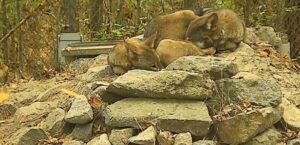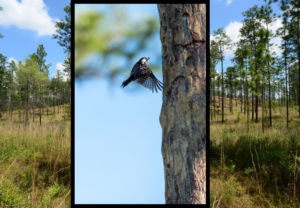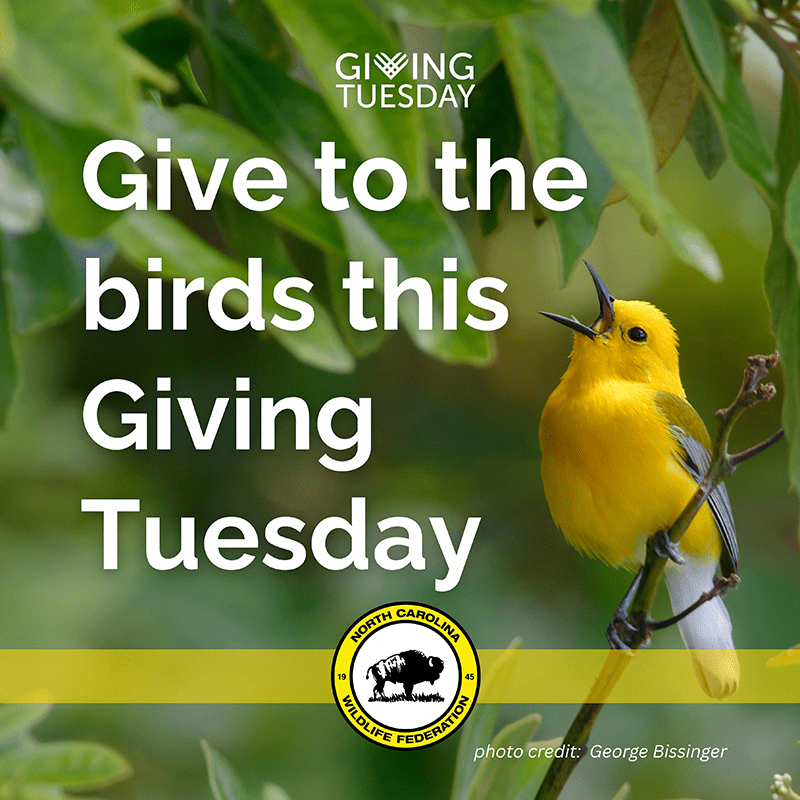Family Matters – Explore North Carolina’s Wildlife Family Units
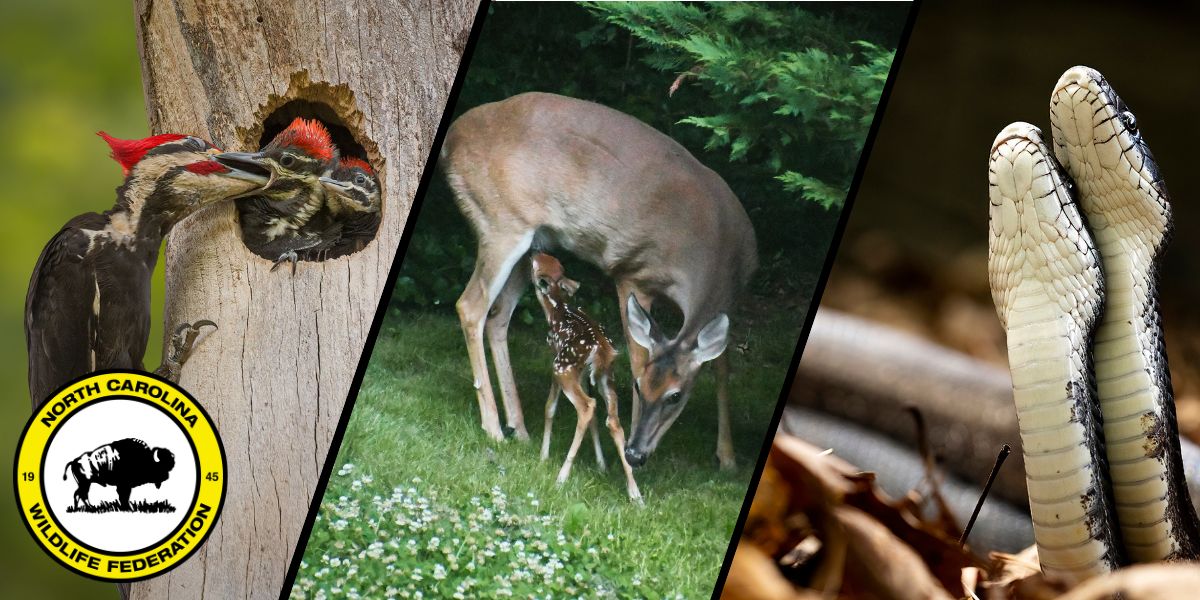
For some, it’s the sound of chicks chirping from a porchside wren nest. For others, it’s the sight of a doe and her yearling fawns from a deer stand. Or perhaps it’s a family of gray squirrels entering a tree cavity together to brave the winter cold.
No matter the form, many of us have witnessed wildlife family units in action—maybe without even realizing it at the time.
The structure of family units among North Carolina’s diverse wildlife varies greatly across species. This blog post explores the dynamics of wildlife family units, looking at the roles of parents, offspring, and even extended family members.
From tightly bonded white-tailed deer to the intricate social structures of dolphins along the coast, we’ll examine how different species organize their family life to ensure survival, reproduction, and social connections.
Factors Shaping Variation Within Wildlife Family Structures
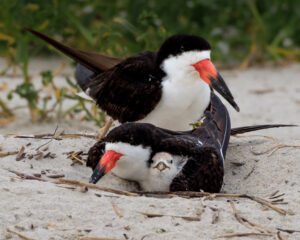
A family of black skimmers (Rynchops niger). (Photo by Evan Maulk, NCWF Photo Contest Submission)
The structure of wildlife family units is shaped by various factors, including mating systems, parental care, social interactions, roles within the group, territorial behavior, and environmental conditions. Each species responds to these influences in its unique way.
As a result, wildlife species can be classified into categories such as monogamous, polygynous, polyandrous, social group living, fission-fusion, solitary, cooperative, and eusocial structures. These categories fall under broader classifications of mating behavior, sociality, and group dynamics.
Many species display a combination of these behaviors, either simultaneously or seasonally. For instance, white-tailed deer exhibit traits of polygyny, group living, fission-fusion, solitary sociality and other family behaviors that change with the season and the demographic makeup of their groups.
The categories outlined below are classified as either mating or social behaviors. However, it’s important to note that, while independent, these traits can influence other characteristics within a species.
Mating: Monogamy in Wildlife – More Than Just Pair Bonding
What is Monogamy?
In wildlife, monogamy refers to a pair of adults forming a long-term or seasonal bond, typically for the purposes of mating and raising offspring. In monogamous systems, both parents usually share the duties of feeding, protecting, and nurturing their young.
While we often hold a special place in our hearts for species that pair for life, it’s important to recognize that lifelong monogamy is just one of many ways animals structure their family lives – and it is not even the most common (Kempenaers).
Much of our admiration for monogamy in wildlife comes from anthropomorphism—the tendency to attribute human characteristics and behaviors to animals. While it’s natural for us to romanticize long term and lifelong partnerships, it’s essential to remember that animal family structures vary widely. Monogamy is just one example among many.
For wildlife, monogamy offers several advantages beyond companionship. Shared parental care is one of the key benefits, as both parents contribute to raising offspring, increasing the chances of survival for the young (US National Science Foundation).
Territorial defense is also a significant advantage, as a pair bond helps defend a territory more effectively from outside threats or competitors (Nature Education).
Finally, reduced mate competition is another benefit, as by forming long-term bonds, monogamous animals reduce competition for mates, which can be particularly beneficial in environments with limited resources (Schuilling).
Seasonal vs. Lifelong Monogamy
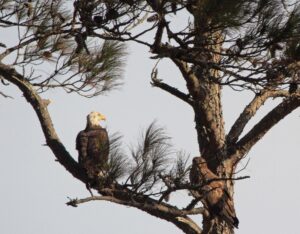
Bald eagles are monogamous, and may display grieving behavior if they lose their mate. (Photo by Karen Bridges, NCWF Photo Contest Submission)
Monogamy in the animal kingdom can be classified into two main types: seasonal monogamy and lifelong monogamy.
- Seasonal Monogamy: In this system, pairs form bonds that last only through the breeding season. Once the season ends, the bond typically dissolves, and the individuals may go their separate ways.
- Lifelong Monogamy: Pairs in lifelong monogamy form long-term bonds that can last for years or even for life, raising multiple generations of offspring together.
Monogamous species, especially those that form lifelong pair bonds, must adapt to the loss of a mate. While most monogamous animals are socially monogamous—meaning they typically form a primary pair bond but may still engage with other individuals, especially after losing a mate—many simply start the process of finding a new partner. However, some species experience a grieving period, during which their activity decreases, and they become more solitary. Swans (Birkhead, 1985), vultures (Bildstein, 1986), Northern cardinals (Sullivan & Klem, 2002), and bald eagles (Steenhoff, 1983) are among the species that may show signs of grieving after the loss of a mate.
Monogamy Across Animal Groups
While monogamy is most commonly observed among wild birds (National Science Foundation), it is not exclusive to this group. Several other animal species, including mammals, fish, and reptiles, also exhibit monogamous behavior. In these species, pairs typically share responsibilities such as raising offspring and maintaining territory.
Monogamous Species in North Carolina
Birds:
- Lifelong: bald eagle, osprey, red-shouldered hawks
- Seasonal: Northern cardinal, Eastern bluebird, wood duck, great horned owl, Eastern screech owl
Mammals:
- Lifelong: Red Wolf, beaver
- Seasonal: otter (dependent on environmental factors), coyotes (obligate monogamists)
Fish & Reptiles (seasonal):
- Marbled Salamander, common garter snake (in some populations), green sea turtle
Monogamy in Ospreys
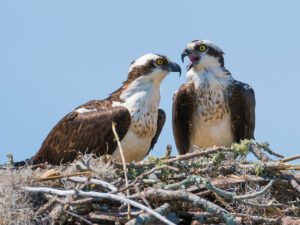
Ospreys engage in lifelong monogamy, and mating pairs will migrate together at the turn of the season.
Ospreys (Pandion haliaetus) are found throughout North Carolina, with their population density varying by region. These birds of prey are typically found near large bodies of water, where they primarily feed on fish, earning them the nickname “fisher hawk.”
Ospreys are mostly monogamous and mate for life, with pairs migrating together and returning to the same nesting sites each year to raise another brood. Although they are predominantly monogamous, rare instances of polygyny or polyandry have been observed (Avian Report).
In North Carolina, osprey breeding occurs from early March through July. The male performs intricate aerial displays to attract the female. If successful, they mate frequently, and the female lays two to four eggs, which do not hatch all at once. Both parents share incubation duties. While the female primarily cares for the young, the male protects the nest from threats and makes frequent trips to gather food for the female and chicks.
Though they migrate together, the female typically leaves first (Avian Report), heading to Central and South America for the winter. The pair later returns to their North American nesting grounds.
Mating: Polygyny in Species Found in North Carolina
In contrast to monogamy, polygyny is a mating system where one male mates with multiple females. This is a common mating type in wildlife and is typically observed in species where the male invests little or no care in raising the offspring. Some examples of polygynous species in North Carolina include white-tailed deer, black bears, bobwhite quail, Eastern wild turkeys, and spotted salamanders. In these systems, males focus on securing mates, while the females generally raise the young on their own.
Polygyny in Black Bears
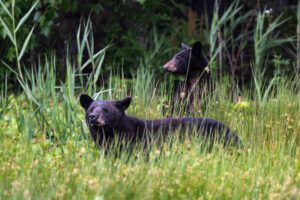
Black bears are a polygenous species, meaning males will mate with several females during the mating season. (Photo by Roger Sulenski, NCWF Photo Contest Submission)
Black bears (Ursus americanus) are a prominent species in North Carolina, particularly in the western mountains and coastal areas. The North Carolina Wildlife Resources Commission reports that black bears inhabit roughly 60% of the state, with territories ranging from 5,000 to 50,000 acres, depending on location and gender (NCWRC). The Albemarle-Pamlico Peninsula, home to Alligator River National Wildlife Refuge, has the highest concentration of black bears in the country (bear-ology).
Black bears are polygamous, exhibiting both polygynous and polyandrous behaviors, though they are primarily polygynous, with males mating with multiple females (Penn State Extension). After mating, the fertilized egg does not immediately implant but remains unattached in the uterus until fall. The gestation period lasts about 235 days, with cubs typically born during mid-winter hibernation. Litters usually consist of one to three cubs.
Male bears play no role in parenting, and females are solely responsible for raising the young. Female black bears are highly protective of their cubs, with the highest incidence of bear attacks occurring when mothers defend their young from perceived threats (Brocke, R. H., & Brocke, J. E. (1984).
Mating: Polyandry: A Less Common System
Polyandry is the least common mating type in wildlife (Kempenaers), and there are very few instances of it in North Carolina wildlife species. Less common than polygyny, polyandry occurs when one female mates with multiple males. In some cases, the males assist in raising the offspring, offering protection or food. Species in North Carolina that exhibit polyandry include spotted sandpipers and red phalaropes.
Polyandry in Spotted Sandpipers
Spotted sandpipers (Actitis macularius) are shorebirds found in North Carolina’s Coastal Plain and Piedmont regions. They inhabit beaches, lakes, ponds, rivers, and streambanks, where they search for small invertebrates such as snails, worms, and insects.
The species displays both polyandrous and monogamous behaviors, depending on the environment. In polyandrous situations, females may mate with up to four males, with each male then caring for a separate clutch of eggs. This represents a role reversal from polygyny, as the female establishes and defends the territory while the male incubates the eggs and cares for the young.
Sociality: Group Living (Social Groups)
Some wildlife species in North Carolina live in groups, sometimes with complex social structures and hierarchies. Group living can offer benefits such as improved protection, enhanced hunting abilities, and increased social bonding. Species that live in social groups include white-tailed deer, Red Wolves, dolphins, wild turkeys, and beavers.
Group Living in White-tailed Deer
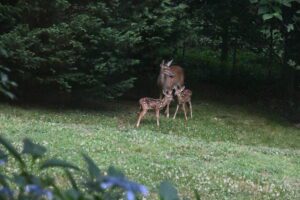
White-tailed deer form social groups during several times of the year, many of which are made up of a doe and her fawns. (Photo by Dee-Dee Schwar, NCWF Photo Contest Submission)
White-tailed deer (Odocoileus virginianus) are the most common and widespread cervid species in North Carolina, with an estimated population of over 1 million (NCWRC). They are found throughout the state and are adaptable to both urban and rural environments, thriving in areas with edge habitats due to their varied diet.
White-tailed deer display a range of mating and social behaviors. They are polygamous, with both polygynous and some polyandrous traits. Although deer are often seen in groups, particularly does with their fawns, they can be solitary for much of the year, especially bucks.
This makes white-tailed deer semi-gregarious, meaning they live in social groups part of the time. Does and their fawns typically form groups and, though a doe may appear to be alone, she may be protecting nearby fawns by diverting the attention of perceived predators (Mass.gov). During summer, male deer, or bucks, may form bachelor groups, which break apart as the mating season approaches in late summer and fall when their testosterone levels rise.
During mating season, dominant bucks gather harems of does, which they mate with throughout the season. White-tailed deer are highly territorial, and their social group dynamics are influenced by local competition, as well as the age, sex, and size of group members.
Sociality: Fission-Fusion Societies
In fission-fusion societies, groups frequently split and reunite, with individuals moving between smaller subgroups. This system allows for flexibility in group composition, helping to reduce competition and ensure genetic diversity. Species in North Carolina that exhibit this behavior include dolphins, northern shovelers, Eastern wild turkeys, and American crows.
Fission-Fusion in Eastern Wild Turkeys
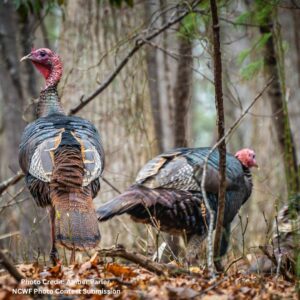 Eastern wild turkeys (Meleagris gallopavo) are the largest game bird in North Carolina and can be found throughout the state, especially in the Piedmont region. As a social species, they primarily travel in groups.
Eastern wild turkeys (Meleagris gallopavo) are the largest game bird in North Carolina and can be found throughout the state, especially in the Piedmont region. As a social species, they primarily travel in groups.
These groups undergo fission-fusion dynamics throughout the year, influenced by factors like demographics and environmental conditions. From mid-summer to fall, several hens and their broods may come together. After the breeding season, bachelor groups are common, often staying together until late winter. By late fall, some toms (adult males) may join flocks of hens and poults (their young).
Wild turkeys are mainly polygynous, with males mating with multiple females. They typically mate in early spring, and the females lay clutches of 10 to 14 eggs around April. While males play little role in raising the young, the poults are often surrounded by both male and female members of the flock due to the species’ social nature.
Sociality: Solitary Animals
Some species, such as black bears, bobcats, raccoons, and eastern diamondback rattlesnakes, lead solitary lives. These animals are primarily responsible for their own survival, including hunting/foraging, protecting territory, and raising their young.
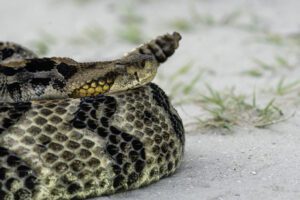
Diamondback rattlesnakes are a solitary species, breaking off from their birth groups days after having been born to set out alone (Photo by Genevieve Rudock (Bostic), NCWF Photo Contest Submission)
Solitary Sociality in Eastern Diamondback Rattlesnakes
Eastern diamondback rattlesnakes (Crotalus adamanteus) are pit vipers and one of the six venomous snake species found in North Carolina. Known for being among the state’s most venomous snakes, they are found primarily in the southeastern Coastal Plain, particularly in longleaf pine flatwoods.
While their habitats may overlap with others, Eastern diamondbacks are solitary creatures, spending most of their lives alone. They only come together during the mating season, which occurs in late summer and early fall. Males are polygamous, often mating with one female for hours. After mating, the male leaves, and the female gives birth to 4 to 32 live young, with an average of around a dozen. The young are born from eggs that hatch inside the mother’s body.
The mother protects her young briefly before they typically venture off on their own at around 10 to 20 days old.
Sociality: Cooperative Breeding
In cooperative breeding, non-parental individuals, often older siblings or other relatives, help raise offspring that are not their own. These helpers assist in tasks like defending the nest (birds), foraging for food, and caring for the young. In North Carolina, species like the eastern bluebird, pine warbler, red-cockaded woodpecker, and northern bobwhite quail exhibit cooperative breeding behaviors.
Cooperative Breeding in Red-cockaded Woodpeckers
The red-cockaded woodpecker (Leuconotopicus borealis) is a small, federally threatened species measuring just seven inches in length. It is a cavity-nesting bird, unique in North Carolina for excavating cavities in living longleaf pine trees, likely because these trees are more resistant to wild and prescribed fires.
While red-cockaded woodpeckers are monogamous, they also engage in cooperative breeding. This means that older siblings and other members of the group assist in raising the young. These “helper” birds contribute by protecting the young, bringing food, and even incubating the eggs.
Females typically lay 1 to 5 eggs in late spring to early summer, which hatch within 10 to 12 days. The fledglings leave the nest 24 to 27 days after hatching.
Cooperative breeding is uncommon among birds. Although not definitively proven, it is believed that individuals help care for the young as a result of sharing territories with other red-cockaded woodpeckers (Sandhills Ecological Institute).
Sociality: Eusocial Species
Eusociality represents the highest level of social organization, where individuals in a species cooperate to an extreme degree. In these systems, typically only one reproductive female (the queen) produces offspring, while the other individuals, such as workers and soldiers, perform other tasks. Species like honeybees, eastern carpenter ants, fire ants, yellowjackets, paper wasps, and termites exhibit eusocial behavior.
Eusocial Behavior in Carpenter Ants
Multiple species of carpenter ants (Camponotus) are native to North Carolina and are one of the most common ant species in the state, found in all regions. Unlike red fire ants (a non-native species), they excavate wood to create their nests, in contrast to other species that build their nests in the ground.
Colony sizes range from 3,000 to 50,000 ants. As a eusocial species, carpenter ant colonies exhibit a complex social structure, often viewed as a “superorganism.” These colonies consist of overlapping generations, with both reproductive and non-reproductive castes that have distinct roles.
Each colony is started by a single queen, who is assisted by her non-reproductive daughters. These workers care for the young, protect the nest, and forage for food. The eusocial structure allows for task specialization and helps the colony balance foraging, reproduction, and nurturing the young without compromise.
Written by:

– Bates Whitaker, NCWF Communications & Marketing Manager
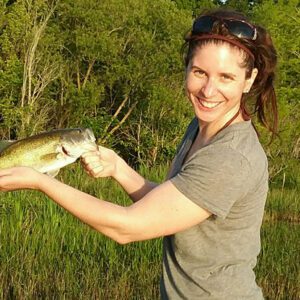
– Dr. Liz Rutledge, NCWF VP of Wildlife Resources
Sources:
- Avian Report. (n.d.). Osprey migration. Retrieved January 23, 2025, from https://avianreport.com/osprey-migration/#:~:text=Ospreys%20migrate%20south%20after%20the,to%20leave%20the%20breeding%20grounds.
- Avian Report. (n.d.). Osprey. Retrieved January 23, 2025, from https://avianreport.com/osprey/#:~:text=to%20the%20next.-,Population%20size,population%20at%201%2C200%2C000%20mature%20individuals.
- Bear-ology. (n.d.). Bear facts. Retrieved January 23, 2025, from https://bear-ology.com/bear-facts-1
- Birkhead, T. R. (1985). The monogamy of the mute swan, Cygnus olor, and the role of mate guarding. Animal Behaviour, 33(4), 1185-1192. https://doi.org/10.1016/S0003-3472(85)80163-1
- Bildstein, K. L. (1986). The role of post-fledging parental care in the social structure of the Turkey vulture (Cathartes aura). The Condor, 88(4), 414-423. https://doi.org/10.2307/1368880
- Black bear | North Carolina Wildlife Resources Commission. (n.d.). Retrieved January 23, 2025, from https://www.ncwildlife.org/wildlife-habitat/species/black-bear
- Black bear | North Carolina Wildlife Resources Commission. (n.d.). Retrieved January 23, 2025, from https://extension.psu.edu/black-bears#:~:text=Black%20bears%20breed%20during%20the,female%20through%20their%20first%20year.
- Brocke, R. H., & Brocke, J. E. (1984). Maternal behavior in black bears: A study of female protectiveness and its relationship to cub defense. Journal of Mammalogy, 65(4), 714-721. https://doi.org/10.2307/1381392
- Deer | North Carolina Wildlife Resources Commission. (n.d.). Retrieved January 23, 2025, from https://www.ncwildlife.org/species/white-tailed-deer#:~:text=Deer%20are%20so%20adaptable%20that,at%20around%201%20million%20animals.
- Fawn phases: Why it’s normal to find fawns alone. (2020, June 23). Massachusetts Government Website. Retrieved January 23, 2025, from https://www.mass.gov/news/fawn-phases-why-its-normal-to-find-fawns-alone
- Nature Education. (n.d.). Mating systems in sexual animals. Nature Education Scitable. Retrieved January 23, 2025, from https://www.nature.com/scitable/knowledge/library/mating-systems-in-sexual-animals-83033427/
- NSF. (2020, November 12). Animal attraction: Many forms of monogamy in the animal kingdom. National Science Foundation. Retrieved January 23, 2025, from https://new.nsf.gov/news/animal-attraction-many-forms-monogamy-animal
- NSF. (2020, November 12). Animal attraction: Many forms of monogamy in the animal kingdom. National Science Foundation. Retrieved January 23, 2025, from https://new.nsf.gov/news/animal-attraction-many-forms-monogamy-animal#:~:text=But%20paternity%20testing%20suggests%20that,%2C%20including%20cockroaches%2C%20are%20monogamous.
- PubMed. (2003). Mate guarding, in particular the, when necessary, polygamy when possible. Retrieved January 23, 2025, from https://pubmed.ncbi.nlm.nih.gov/12685340/#:~:text=Mate%2Dguarding%2C%20in%20particular%20the,when%20necessary%2C%20polygamy%20when%20possible.
- ScienceDirect. (2022). Social polyandry: Refers to systems, in two fundamentally different types. Trends in Ecology & Evolution. https://www.sciencedirect.com/science/article/pii/S0960982222010314#:~:text=Social%20polyandry%20refers%20to%20systems,in%20two%20fundamentally%20different%20types.
- ScienceDirect. (2022). Species examples of monogamy and polygynandry. Trends in Ecology & Evolution. https://www.sciencedirect.com/science/article/pii/S0960982222010314#:~:text=Drawings%20show%20examples%20of%20species,)%20and%20polygynandry%20(G).
- Sandhills Ecological Institute. (n.d.). Red-cockaded woodpeckers. Retrieved January 23, 2025, from https://sandhillsecological.org/education/red-cockaded-woodpeckers/#:~:text=This%20life%20history%20strategy%20is,cavities%20for%20roosting%20and%20nesting.
- Sullivan, K. A., & Klem, D. (2002). Northern cardinal behavior in response to mate loss: A study on the emotional responses in avian species. Journal of Avian Biology, 33(4), 293-301. https://doi.org/10.1034/j.1600-048X.2002.300312.x
- Steenhoff, K. (1983). Bald eagle behavior after mate loss in the Pacific Northwest. Journal of Raptor Research, 17(3), 85-93. https://doi.org/10.2307/3675729


